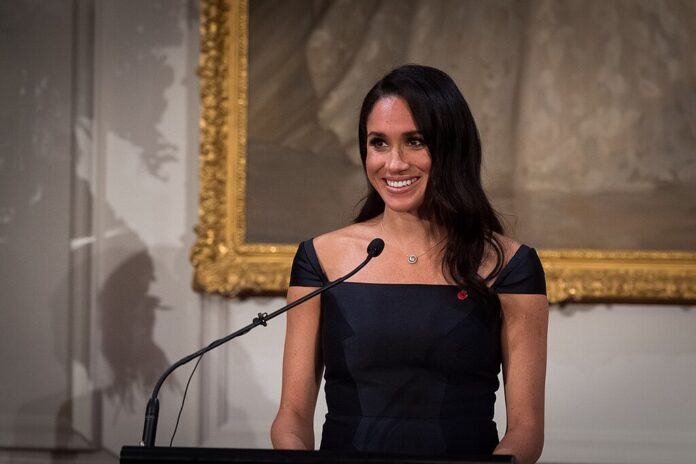Expert insights reveal Meghan Markle’s challenges within the royal family and her subsequent exit, focusing on her aspirations and public life
Meghan Markle, who, along with Prince Harry, stepped back as a senior royal in March 2020, faced significant challenges in understanding her royal role. The Duchess of Sussex, actively involved in numerous charities during her tenure, struggled with the constraints and expectations of royal life. Despite her keen interest in mental health, women’s rights, animal welfare, and community cohesion, Meghan’s relatively short tenure within the Royal Family left many observers surprised.
Former BBC Royal correspondent Jennie Bond shared her perspective with OK!, stating, “I have always held the view that Meghan failed to understand that she would never be the top dog in the Royal Family… or even the deputy top dog.” Bond elaborated, highlighting that Meghan’s ambitions and desire for control were at odds with the structure of the Royal Family. “There’s nothing wrong with wanting to be in complete control and charge of your life. It’s just that the Royal Family was the wrong vehicle for her ambitions,” Bond commented.
Embed from Getty ImagesHowever, Bond also offered insights into Meghan’s true aspirations, suggesting that public perceptions might not fully capture her motivations. “I’m not sure she craves a superstar profile. In fact, she’s been quite low-key in recent times, presumably enjoying her family life in California. But she has projects in the pipeline with her website, and I’m sure she will enjoy being in control of every detail,” Bond noted. Meghan’s independent spirit and strong views, Bond suggested, are perfectly aligned with her current endeavours.
In contrast to Meghan, Princesses Beatrice and Eugenie have chosen quieter, more independent lives. Royal commentator Jane Barr, writing in the From Berkshire to Buckingham newsletter, argued that Meghan’s desire for a high-profile role was incompatible with the Royal Family’s expectations. “She [Meghan] would not have been happy with the ultimately quiet or truly independent/non-royal lives that William and Harry’s cousins actually live,” Barr asserted.
Barr further explained the dynamics of Harry and Meghan’s exit from royal duties, known as “Megxit.” Harry, being the son of the future King, always held a prominent position within the royal hierarchy, unlike his cousins. “Harry seems so bitter about being the spare, but he has always been quite senior to his cousins, and treated accordingly,” Barr remarked. This seniority, coupled with Meghan’s aspirations, created friction with the expectations placed on them.
Meghan’s recent activities, including a trip to Nigeria with Prince Harry, have continued to draw attention. Commentator Duncan Larcombe suggested that Meghan often overshadows Harry due to her strong personality and ambitions. “Meghan is a very strong character, very driven, extremely ambitious, and those are the kind of characteristics that mean she will almost always inevitably outshine Harry and grab the attention from him. Harry is entirely in her shadow. But he’s never really been at ease with the attention, he’s never really enjoyed it,” Larcombe observed.
During the couple’s Nigeria tour, Meghan reportedly stole the limelight, turning the trip into “The Meghan Show,” according to Larcombe. This dynamic has led to ongoing speculation about the couple’s roles and future within the public eye.
Analysis:
Meghan Markle’s experience within the Royal Family and her subsequent departure offer a rich tapestry for analysis from various perspectives. From a sociological viewpoint, her struggle highlights the challenges of adapting to institutional norms and expectations, especially when they conflict with personal ambitions and values. Meghan’s desire for control and a high-profile role clashed with the hierarchical and tradition-bound structure of the Royal Family, which operates on principles of duty and continuity.
Economically, Meghan and Harry’s exit from royal duties has significant implications. Their shift towards independent ventures, including media deals and philanthropic activities, reflects a broader trend of modern royals leveraging their status for entrepreneurial endeavours. This approach not only redefines their roles but also impacts the financial dynamics of the Royal Family, which traditionally relies on state funding and private income.
Politically, the couple’s move to California and their outspoken nature on various social issues have positioned them as influential figures outside the conventional royal framework. Their advocacy on mental health, racial justice, and other global issues contrasts with the Royal Family’s more reserved public stance, indicating a shift towards a more engaged and vocal form of royalty.
Gender dynamics play a crucial role in Meghan’s story. Her experiences reflect the broader challenges women face in balancing personal ambitions with societal expectations. The scrutiny and criticism she endured highlight the double standards often applied to women in the public eye, particularly those in positions of power or influence.
From a cultural perspective, Meghan’s background as a biracial American actress brought a unique dimension to the Royal Family, traditionally seen as a bastion of British heritage and customs. Her presence and subsequent departure underscore the tensions between modern multiculturalism and established traditions, sparking debates on inclusion and diversity within the monarchy.
On a personal level, Meghan’s journey illustrates the complexities of navigating public life and personal fulfilment. Her focus on family life and independent projects in California suggests a redefinition of success and happiness, moving away from the rigid confines of royal duties towards a more self-determined path.
In conclusion, Meghan Markle’s tenure and exit from the Royal Family provide a multifaceted case study on the intersections of ambition, tradition, gender, and cultural identity. Her story continues to evolve, reflecting broader societal changes and the ongoing redefinition of royal roles in the 21st century.
